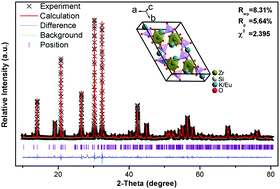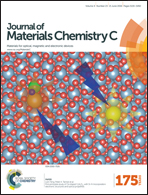Novel zirconium silicate phosphor K2ZrSi2O7:Eu2+ for white light-emitting diodes and field emission displays
Abstract
A novel blue-emitting zirconium silicate phosphor K2ZrSi2O7:Eu2+ was prepared by solid-state reaction for the first time, and its crystal structure was determined from the XRD profiles by using Rietveld refinement and high-resolution transmission electron microscopy (HRTEM). The photoluminescence properties were investigated for the possible application in white light-emitting diodes (LEDs). The excitation spectra of the Eu2+ doped K2ZrSi2O7 phosphor show broad band excitation in the 250–410 nm region, and upon excitation at 350 nm, this phosphor showed a strong blue emission centered at 462 nm (full-width at half-maximum (FWHM) ∼ 70 nm). The thermal stability can be enhanced significantly by solid solution. The cathodoluminescence properties of K2ZrSi2O7:Eu2+ were also studied. Under continuous low-voltage electron bombardment, the phosphors display excellent degradation resistance and good color stability. A white LED fabricated with this phosphor and yellow-orange emitting phosphor Sr3SiO5:Eu2+ on a LED chip (λmax = 375 nm) was discussed. Driven by a 350 mA forward bias current, the fabricated lamp gives intense white light with a higher color rendering index of 86. All the results indicate that this phosphor has potential application in LEDs and FEDs.


 Please wait while we load your content...
Please wait while we load your content...